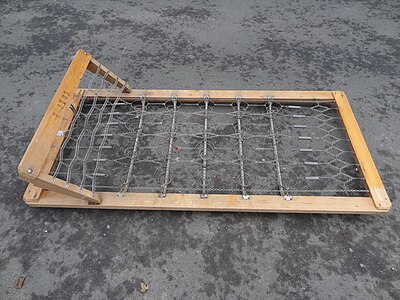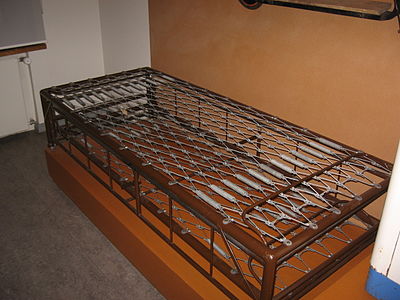Bed base
This article needs additional citations for verification. (July 2018) |

A bed base, sometimes called a foundation, is the part of a bed that supports the mattress. The bed base can itself be held in place and framed by the bedstead (bed frame). In the United States, box-spring bed bases are very common (to the point where 'bed base' and 'box spring' may be used synonymously, and the term "platform bed" is used for any other type of bed base). In Europe, sprung slats are much more common.
Typically the measurements of a foundation will be about 1–2 inches (2.5–5.1 cm) shorter than the measurements of a mattress. In hot climates, mattress may be omitted.
Types
Floor beds
-
An iCansi sleeping mat is often made of iNcume (a species of rush). Mtonjaneni Zulu Historical Museum, northern KwaZulu-Natal
-
Self-inflating camping mat, filled with rebounding foam
-
Official-issue sleeping mat and blanket,Robben Island Maximum Security Prison, South Africa
-
Basic straw mattresses in Nova Scotia, Canada
-
Gandhi's bedroom
-
Bed in the City Palace, Jaipur
-
Beds in the West were just floor beds
-
Micronesian sleeping mat
-
Bedsset out to air, Bougainville Island, Solomon Islands, c. 1944. The broad planks are beds; short lengths of bamboo are pillows.
Floor beds have no bedframe; the mattresses are laid straight on the floor.
The oldest known human beds are 77,000 years old; they were found in the Sibudu Cave in South Africa. They are made of layers of sedges, rushes and grasses, collected from the uThongathi River which runs directly below the sandstone cliff. The beds are mostly made of river wild-quince (Cryptocarya woodii), which repels insects when crushed. Such beds continued to be made at the site for 40,000 years. They were replaced at intervals. After the first 4000 years, inhabitants began burning the bedding regularly. It's thought that these beds were used as daybeds, as well as for sleeping.[1]
Some floorbeds weave plant stems and leaves into mats. Sleeping mats or
Plant stems and leaves can also be stuffed into cloth bags (made from a type of fabric called
A mattress can be lifted,
The futon widely used in Japan is a floorbed, stored in a cupboard during the day. The futons are thin enough to be washed and dried. Futons are traditionally laid on plank floors covered with tatami mats.
Masonry beds
-
The stone boxes are thought to have held bedding. Skara Brae (occupied 3180 BC to about 2500 BC)
-
A similar wooden bed filled with straw, but without bedding, at a museum in Denmark
-
Brick bed, Pompeii
-
Making shoes on a kang during the day,Chongli District, China. Note bedding, most of it folded and stacked.
Masonry box frames, thought to have been filled with bedding, have been identified at Skara Brae (occupied 3180 BC to about 2500 BC).
While masonry is not soft, a masonry platform can elevate a sleeper above the floor. Mud-brick platforms, covered in mats, were used as furniture by poor people in Ancient Egypt.[3]
Plank beds
Plank beds raised above the floor on trestles were used in Europe, but use declined in the 1600s.[2]: 481 vol3
Woven bed bases
-
Plaster moulds of bedframes from the 1500s BC Akrotiri settlement, looking like modern charpais. Such frames are light; one has been stacked upside-down on another. Note turned wood leg, far right.
-
Bed of Queen4th Dynasty of Egypt, circa 2575-2528 B.C. Bed is 177 cm (5ft 9in) long.
-
The 600s (7th-century) Anglo-Saxon Trumpington bed burial held a 60cm by 155cm bed with pieces of looped wrought iron, which may have held the bed base.[1][2] The beds are thought by the excavators to have been the ones used in life, not purpose-made grave goods.[3]
-
Thebedlinen.
-
The fairytale The Princess and the Pea exaggerates the layering of thin mattresses common in traditional European beds
Rope beds support the mattress or sleeper with a lattice of rope. Other woven bases use braid, straps, rushes, cloth or other weaving materials.
Some of the earliest surviving beds are from Ancient Egyptian tombs. These beds have wooden frames, glued and lashed together.[4] In some cases the woven bed support survives. Some Ancient Egyptian beds were made with reeds or plaited string.[3]
In hot climates, ventilation through the woven bed base helps keep the sleeper cool, and the bed base is sufficiently flexible not to need padding.[5]
In cold climates, a woven bed base would be topped with insulation. Traditionally, in Europe and the Americas, this was one or more insulating mattresses: cloth bags stuffed with a variety of materials (see above), and possibly also a canopy hung with warm curtains.[6][7] Modernly, it might be topped by a thin futon or other roll-up mattress.[8]
Parallel-woven bed bases
-
Traditional Ethiopian bed frames, lathe-turned and handcarved, Rock-Hewn Churches, Lalibela.
-
Traditional American rope bed, circa 1939. Note loops of rope through frame, and tensioning wedge at near corner.
-
Medieval-reconstructionmadder-dyed red blankets.
-
Parallel-woven charpai in Rajasthan, tipped up against the wall for the day
-
Woven bed base inPeruvian rainforest
Many traditional European rope beds are woven with the ropes parallel to the ends and sides of the bed. They need to be tightened regularly (with a bed key (UK) or bed wrench(US), and sometimes with wedges) as they sag. They must also be re-strung occasionally; re-stringing reduces sag and evens out wear.[9][8][10] When fully or partly unstrung, they can be packed flat for transport.[8]
Bias-woven bed bases
-
A small charpoi in Pakistan, 2019, showing structure, and retensioning lashing.
-
An 800s European Healing at Bethesda scene, showing a bias-woven rope bed
-
Santhal bed woven of sabai grass
-
Cats in a sagging charpai
-
Charpais used as daybeds in Rajasthan
Some rope beds are
Cloth bed bases
-
A chest-hideabed in the Casona de Tudanca, with lashings to retension it.
-
A mid-20-century folding camp bed, wood, cotton duck, and metal
-
Very similar beds, but with aluminum frames and a lighter, less taut cloth, in aRed Crossshelter in 2009
-
An aluminum folding bed, of the sort widely used in many Eastern Bloc countries.[citation needed] The cloth is tensioned by metal springs all round
With cheap mass-produced cloth, it became increasingly practical to use cloth as a bed support. Retensioning issues remained, so the cloth was sometimes attached to the frame by lashings or springs.
Inflatable bed bases
Air mattresses are recorded in the 1400s; Louis XI, king of France, had one made of leather.[2]: 498 vol3
Sprung beds
Wooden slats

An all-wood foundation usually has seven or eight support slats, long laths of wood laid across the frame.
The Ancient Egyptians used slatted beds,[3] and the Ancient Greeks may have used them.[11]
In Europe, bedslats were at one point nailed to the frame, but that made disassembling a bed very difficult. In the 1400s, the slats were all attached to two lengthwise straps, and their ends laid loosely on ledges built on both sides; the ledge held them up, and the straps stopped them from sliding along and bunching up (which would leave holes the mattress could slide through). This assemblage of loosely-linked slats could easily be rolled up and transported with the disassembled bedframe.[2]: 481vol3, 674vol1 : 675-6 vol1 [12] Such slat bases are still in widespread use today.
More modernly, the slats may be topped by a sheet of
All-wood slat foundations, initially rare in the U.S., have become increasingly prevalent as U.S. mattress makers shifted to super-thick, one-sided mattresses (as of 2012[update]).[13]
Metal springing
-
A woven-steel bed base
-
A steel-strap bed base in Chinawal village, India
-
Springs bound only at the top, and set upon steel slats. 1970s Germany
-
Longitudinal springs, with a wire net between them. Model manufactured in Finland from 1932 to 1964
A grid-top foundation is a combination of steel and wood.[clarification needed]
Box springs
-
The corner of a boxspring, without its cloth covering. This boxspring has a wooden frame with wooden slats
-
Repairing an all-metal boxspring in Cuba
A traditional box spring consists of a rigid frame containing extra heavy duty springs. This foundation is often paired with an innerspring mattress, as it extends the life of the spring unit at the mattress's core.[citation needed] Legs may be attached directly to the bottom of a boxspring, if it has a suitable frame, or the boxspring may be laid on a bedframe or another bed base.
In the US, box springs are sufficiently universal that any non-boxspring-bed is called a platform bed.
References
- ^ Choi, Charles Q. (8 December 2011). "World's Oldest Bedding Discovered in Cave". LiveScience. Retrieved 28 June 2014.
- ^ a b c d Havard, Henry (1887). Dictionnaire de l'ameublement et de la décoration depuis le XIIIe siècle jusqu'à nos jours. Getty Research Institute. Paris, Ancienne maison Quantin, Librairies-imprimeries réunies, May & Motteroz.
- ^ a b c Springer, Ilene. "How the Ancient Egyptians Put Their Feet Up: Furnishings in Ancient Egypt". Retrieved 8 January 2024.
- ISBN 978-0-7509-3728-3.
- ^ ISBN 9780330418799.
- ^ Karstensen, Rebecca (2018-01-18). Graves, Jean (ed.). "Sleep Tight, Don't Let the Bed Bugs Bite – A Myth Debunked". libraries.indiana.edu.
- ^ "Canopy beds and rope beds". Greydragon Furniture collection.
- ^ a b c Devin, Harold. "Making a Rope Bed" (PDF). Archived from the original (PDF) on 2016-03-26.
- ^ Wright, Bryan. "Colonial Sense: How-To Guides: Interior: Bed Roping". Colonial Sense.
- ^ "The Stamford Historical Society, A virtual tour through the Hoyt-Barnum House". www.stamfordhistory.org.
- ^ "Unique archaeological finding in Kozani: Deceased woman on wooden bed". Keep Talking Greece. 2021-04-28. Retrieved 5 June 2021.
- ^ "Everything you need to know about beds base". SleepTech. Retrieved 2024-01-08.
- ^ Nelles, Barbara (1 February 2012). "New features rev up steel frames & support systems". BedTimes Magazine. Retrieved 8 January 2024.
External links
 Media related to Bed bases at Wikimedia Commons
Media related to Bed bases at Wikimedia Commons


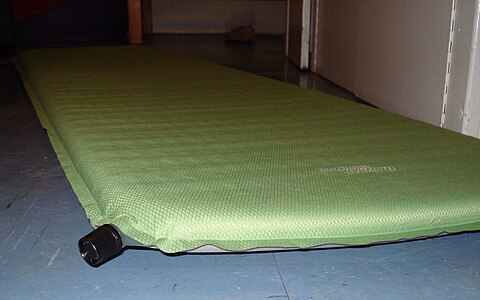





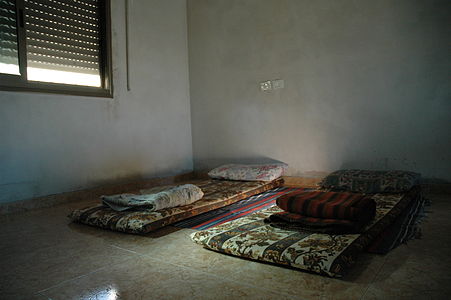



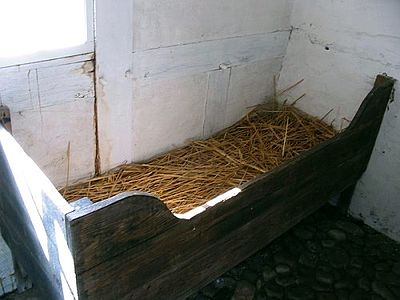
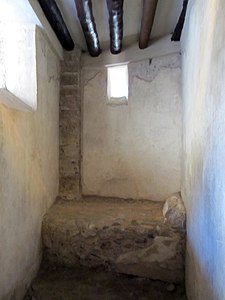



![The 600s (7th-century) Anglo-Saxon Trumpington bed burial held a 60cm by 155cm bed with pieces of looped wrought iron, which may have held the bed base.[1][2] The beds are thought by the excavators to have been the ones used in life, not purpose-made grave goods.[3]](http://upload.wikimedia.org/wikipedia/commons/thumb/e/e8/Iron_Fittings_from_the_Trumpington_Bed_Burial_in_the_Cambridge_University_Museum_of_Archaeology_and_Anthropology.jpg/450px-Iron_Fittings_from_the_Trumpington_Bed_Burial_in_the_Cambridge_University_Museum_of_Archaeology_and_Anthropology.jpg)



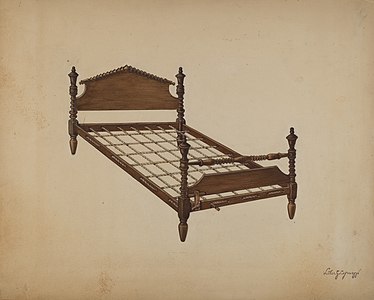





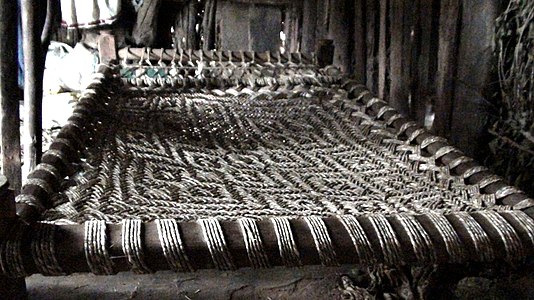

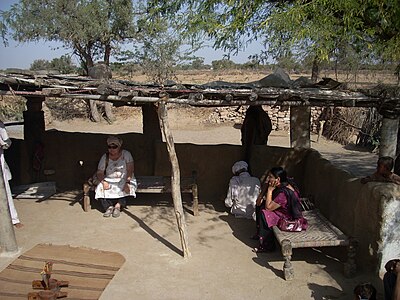
![A chest-hideabed in the Casona de Tudanca [es], with lashings to retension it.](http://upload.wikimedia.org/wikipedia/commons/thumb/0/02/Casona_de_Tudanca_%2820%29.jpg/452px-Casona_de_Tudanca_%2820%29.jpg)


![An aluminum folding bed, of the sort widely used in many Eastern Bloc countries.[citation needed] The cloth is tensioned by metal springs all round](http://upload.wikimedia.org/wikipedia/commons/thumb/d/df/P240110_17.27_-01-.jpg/400px-P240110_17.27_-01-.jpg)


